Easy Twisted Croissant French Bread
This twisted croissant French bread looks fancy, but it is SO easy to make at home and is a total showstopper. So buttery and fluffy and yummy!
Making croissants at home can be an intimidating multi-day, multi-step affair.
But making twisted croissant French bread at home only takes a couple of hours, and the result is a flaky, buttery, twisted croissant-style bread that is literally out of this world delicious.

Very Simple French Bread Dough
The dough we’re using for this recipe is actually adapted from my beloved, popular breadstick recipe.
It is such a simple, foolproof dough and so easy to work with – it is perfect for this croissant bread!
Using any stand mixer of your choice (or making it by hand with a bowl and spoon), mix and knead the dough ingredients until a soft, smooth dough forms.
It’s REALLY important that this dough is not over floured and stiff or you’ll be cursing everyone’s name trying to roll it out. On the flip side, a dough that is too soft and sticky can be problematic, too. Try for a dough that is soft and slightly sticky but easily clears the sides of the bowl. It should leave a light residue on your fingers but not be overly wet and sticky.

Let the dough rise until doubled in size, about an hour.
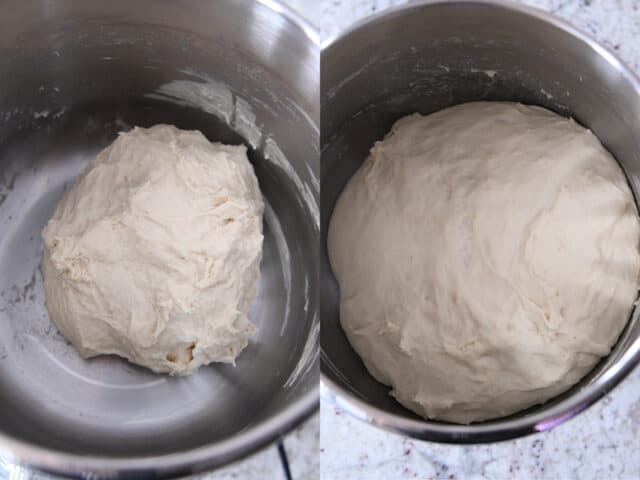
The Butter Packet
This croissant bread requires making a thin sheet of butter that gets folded and rolled into the bread dough.
To make the butter packet:
- Grab a piece of parchment paper about 16 1/4-inches by 12-inches (doesn’t have to be exact, but should be close to those dimensions). The precut sheets are about this size.
- Fold the two short edges on each side in toward each other about 4 1/2 inches. They will overlap a bit. Crease the edges well.
- Keep those edges folded in and fold the top and bottom edges over about 1 3/4-inches.
- When all the edges are folded in, it will form a little parchment packet with the center rectangle dimensions about 8 1/2-inches by 7-inches.
Don’t stress too much about the folding – these are just guidelines. If the folds are off by a little bit, it’s not going to be a problem as long as the folds completely enclose the center area where the butter will go.
Below is a reference chart with the parchment and dimensions.

Take two sticks of butter at cool room temperature and cut into several big pieces.
Unfold the parchment and place the butter in the center of the parchment. Fold up the packet using the pre-creased folds and flip over so the folded edges are on the bottom.
Use a rolling pin, lightly tap the butter (too much aggression here and the parchment could rip) until it starts to flatten and merge into a thick square.
Continue tapping the butter and eventually transition to using the rolling pin to roll the butter into a thin sheet so it reaches all the edges of the parchment packet using short quick rolls with the pin. It should evenly thick throughout.
Place the butter packet in the fridge to chill while you make the dough.

How to Fold the Croissant French Bread
When the dough has risen and butter has chilled, lightly punch down the dough and turn out onto a lightly floured counter.
Roll the dough into a rectangle about 18-inches by 11- or 12-inches.
Take the butter packet out of the refrigerator, and unfold the parchment (but leave the butter on the parchment paper). Place the butter packet face down on the center of the rolled out bread dough. Peel the parchment carefully off the butter leaving the butter sheet on the dough.
Using the pictures below as a reference, begin by folding one short side of dough about halfway to 2/3 over the butter. Fold the other short side of dough over the butter, overlapping the first folded side by about an inch.
Fold the top and bottom edges over about 1/2- to 1-inch and press to seal and then fold the dough in half lengthwise to form a rectangle loaf.

Rolling, Rolling and More Folding
Roll the thick, folded loaf into a long rectangle about 8-inches by 22-inches. If the dough springs back when rolling, let it rest for 5-10 minutes to let the gluten relax and roll again.

Fold one short edge of the long rectangle into the center (pictures below). Repeat with the other short edge so they meet in the middle. Fold the dough in half (from one of the short sides).
Let the dough rest for 2-3 minutes. This helps relax the gluten so it is easier to keep rolling out.
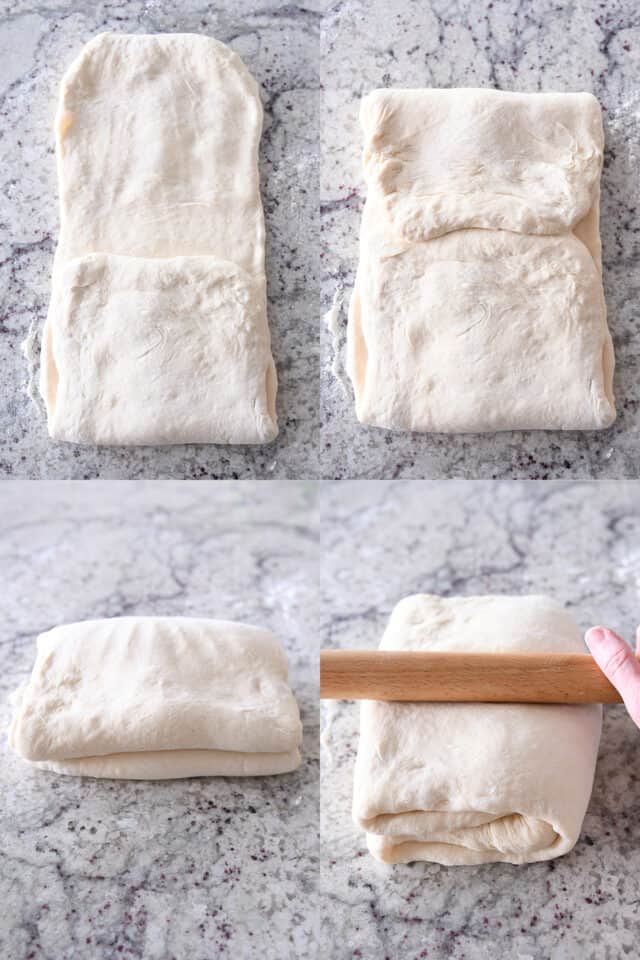
Roll the folded dough into a 12-inch or 13-inch square. You might see little bubbles on the surface of the dough. Totally normal (don’t deliberately pop them!).
Cut the square into four strips.
Pro Tip: you can cut the dough into even thinner/smaller strips for twisted croissant breadsticks!

Rising and Baking the Croissant French Bread
Place the twisted croissant loaves on a parchment-lined half sheet pan (I place two loaves per sheet pan, spaced a few inches apart).
Cover and let the dough rise until noticeably puffy. This dough can rise slowly in the refrigerator for several hours or overnight. Don’t let it rise in an overly warm spot or the butter will melt before it hits the oven and you won’t get the delicious, flaky, buttery layers.
Bake in a preheated oven until golden. The smells emanating from your oven are going to be incredible. Hot, fresh, buttery, baked bread. Be still, my heart.

Bonus Tip: Brush with Butter
It’s inevitable to have some leaked butter on the sheet pan when you pull the bread from the oven.
This is actually preferable!
Take a pastry brush and brush the butter on the sheet pan over the top of the warm bread.

The Most Incredible Bread Ever
This twisted croissant French bread has become my secret weapon.
I’ve made it dozens of times over the last month for us to enjoy, to serve to company, and to take to friends/neighbors.
To say it is an absolute showstopper is an understatement. Everyone is bowled over at how deliciously amazing this bread is. It’s soft and fluffy…but also buttery and flaky.
It can be cut into slices…but more often, we tear off pieces and go the all out rustic route.
Served warm, this bread is absolutely decadent and irresistible.
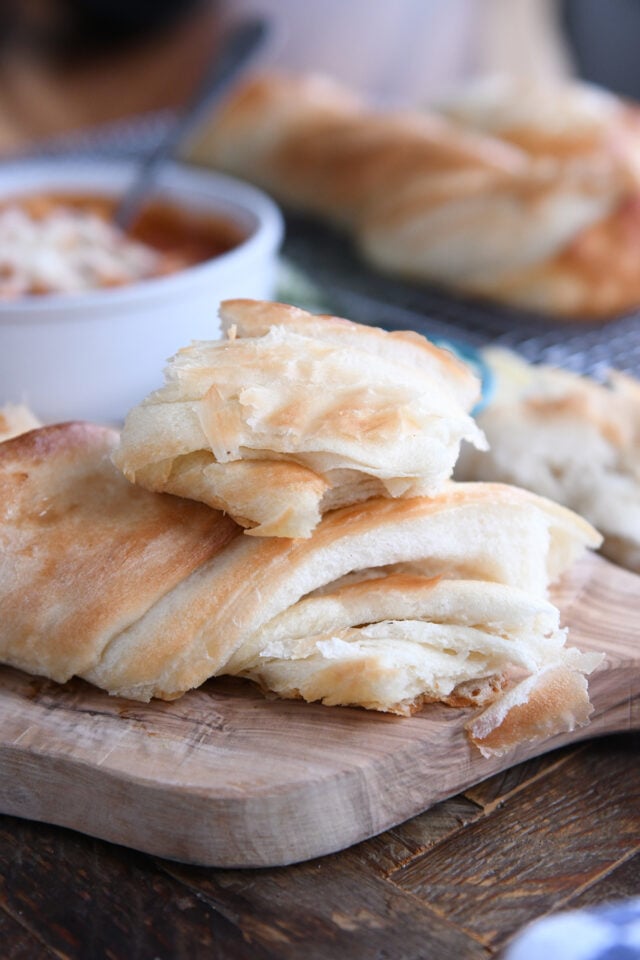
Homemade Croissants vs Croissant French Bread
I have made homemade croissants approximately one time in my life. They were good but super time intensive and honestly, VERY stressful.
This twisted croissant French bread, on the other hand, is made start to finish in a couple of hours, and is so easy and delicious, I don’t think I’ll ever be tempted to make homemade croissants again.
I can’t wait for you to make this! It’s going to change your bread making life!
{Note: See below the recipe for where the inspiration for this bread came from.}
{Second Note: I made a quick how-to video of this bread and posted it over on Instagram for those that like more visual instructions!}

One Year Ago: Swedish Pancakes
Two Years Ago: Easy Yogurt Flatbread
Three Years Ago: Easy Homemade English Muffins {Whole Grain Option – No Mixer Needed!}
Four Years Ago: Super Easy S’Mores Chocolate Pie {or Tart}
Five Years Ago: Incredible Fluffy Overnight Buttermilk Pancakes
Six Years Ago: Chinese Cashew Chicken {30-Minute Meal}
Seven Years Ago: Double Chocolate Quick Bread
Eight Years Ago: Healthier Banana Bread Chocolate Chip Oat Snack Bars
Nine Years Ago: Family Style Shrimp Scampi {20-Minute Meal}
Ten Years Ago: Chocolate Tres Leches Cake

Easy Twisted Croissant French Bread
Ingredients
- 1 cup (227 g) salted butter, cool room temperature
- 2 cups warm water, 105-110 degrees F
- 1 tablesoon instant or active dry yeast
- 2 tablespoons granulated sugar
- 1 1/2 teaspoons salt
- 4 3/4 (675 g) cups all-purpose flour, more or less (see note)
Instructions
- For the butter packet: grab a piece of parchment paper about 16 1/4-inches by 12-inches (doesn't have to be exact, but should be close to those dimensions). Fold the two short edges of the parchment in toward each other about 4 1/2 inches. They will overlap a bit. Crease the edges well.
- Keep those edges folded in and fold the top and bottom edges in about 1 3/4-inches. It should form a little parchment packet when folded with the center rectangle dimensions about 8 1/2-inches by 7-inches. See pictures in the post for a visual.
- Unfold the parchment. Cut the butter into large pieces and place in the center of the parchment. Fold up the packet using the pre-creased folds and flip over so the folded edges are on the bottom.
- Use a rolling pin, lightly tap the butter (too much aggression here and the parchment could rip) until it starts to flatten and merge into a thick square. Continue tapping or use the rolling pin to roll the butter into a thin sheet so it reaches all the edges of the parchment packet and has a relatively even thickness. Place in the fridge to chill while you make the dough.
- For the dough: In the bowl of a stand mixer fitted with the dough hook, add the water, yeast and sugar, and let sit until foamy, 2-3 minutes. Add the salt and flour and mix until a soft dough forms that clears the sides of the bowl. Add more flour, a little at a time, if the dough is sticking to the dough hook or sides of the bowl.
- {It's REALLY important that this dough is not over floured and stiff or it will be hard to roll it out. On the flip side, a dough that is too soft and sticky can be problematic, too. Try for a dough that is soft and slightly sticky but easily clears the sides of the bowl. It should leave a light residue on your fingers but not be overly wet and sticky.}
- Knead for 3-4 minutes until the dough is soft and smooth.
- Cover the bowl or transfer the dough to a lightly greased bowl and cover. Let rise until doubled, about an hour.
- Lightly punch out the dough and turn out onto a lightly floured counter. Roll into a rectangle about 18-inches by 11- or 12-inches.
- Take the butter packet out of the refrigerator, and unfold the parchment (but leave the butter on the parchment paper). Place the butter packet face down on the center of the rolled out bread dough. Peel the parchment carefully off the butter leaving the butter sheet on the dough.
- Work quickly and don't over work the dough during the next couple steps of folding and rolling so the butter doesn't get too soft!
- Fold one short side of dough about halfway to 2/3 over the butter. Fold the other short side of dough over the butter, overlapping the first folded side by about an inch.
- Fold the top and bottom edges over about 1/2- to 1-inch and press to seal.
- Fold the dough in half (from right to left or vice versa) once more.
- Starting in the center, roll the dough out into a long, thin rectangle, about 8-inches by 22-inches. If the dough springs back when rolling, let it rest for 5-10 minutes to let the gluten relax and roll again.
- Fold one short edge of the long rectangle into the center. Repeat with the other short edge so they meet in the middle. Fold the dough in half (from one of the short sides).
- Let the dough rest for 2-3 minutes. Prepare two half sheet pans by lining with parchment paper. Preheat the oven to 375 degrees F (400 degrees F for a darker crust).
- Roll into a 12-inch or 13-inch square. If the dough springs back when rolling, let it rest for 5-10 minutes to let the gluten relax and roll again. Cut the square into four strips.
- Take each strip, twist it 3-4 times and place on the prepared sheet pans (two strips per sheet pan, spaced several inches apart).
- Cover and let rise until noticeably puffy (the dough can rise in the refrigerator overnight or for several hours – when taking out of the refrigerator, if it hasn't risen enough, let it come to room temp and continue rising until nearly doubled). You don't want to let these loaves rise in an overly warm spot or the butter will melt before it hits the oven and you won't get the flaky, buttery layers.
- Bake the loaves until nicely golden, 20-22 minutes.
- Immediately out of the oven, use a pastry brush to brush any leaked butter on the sheet pan over the top of the loaves.
- Serve warm or at room temperature. Bread can be sliced or torn into pieces.
Notes
Recommended Products
Recipe Source: from Mel’s Kitchen Cafe, inspired by @mollyjwilk on Instagram who made a version of this with @thefoodnanny baguette recipe. I simplified by using my easy breadstick recipe (increased the recipe to make four perfect little loaves, and I also fleshed out the instructions with dimensions for the butter packet as well as altering the folding and rolling method a bit with an extra fold in the first set of folding/rolling and brushing the extra butter on the loaves at the end







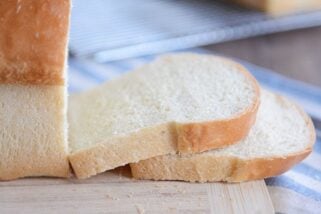
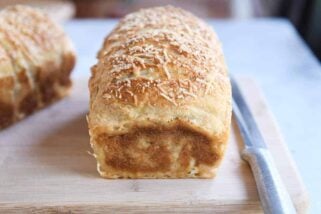
This is The Bread. The bread that all other breads will forever be compared to! The bread that made all 5 of us moan with desire. The bread that smells like heaven and tastes even better! The bread that makes other bread taste like dust! Thank you, Mel, for changing our lives forever for the better with This Bread!!!
I just made this recipe and ate this bread and now I don’t care about any other foods. This is all I want to eat forever.
Hahahaha.
This bread is incredible! The crispy bottom and the pillowy layers make for such a delicious bread. Thank you for sharing it with us!!
Can I give this 10 stars?? It looks elegant and tastes divine. All those beautiful flaky twists and butter! I’ll be making this one again. It was much easier to make than I anticipated. Thanks for another great recipe, Mel!
Loved it! I made it as a side for our soup tonight. It was fun to try something different and we all loved it.
So delicious! I usually always have a hard time making doughs with yeast, but this one has worked out every time. Everyone who tries it, loves it. Thanks for this wonderful recipe.
Hi Mel! This recipe is divine!!! Love it. Do you know if the bread freezes well? Thanks for always supplying us with the best recipes.
Hi Tori! We devour this bread so fast I haven’t tried freezing…but my guess is it should freeze fine. It will definitely get a boost from being lightly warmed once thawed (due to the butter)
Amazing!!! I could honestly eat an entire loaf by myself….and then some!
Any tips on how to get a left over loaf the same texture as a fresh one? Pop in the oven for a little? It’s delicious the next day but a very different texture as right out of the oven.
Thanks!!
Hi Jenna, I don’t think anything will quite beat the fresh-from-the-oven bread, but you could try popping it in the oven to warm up a bit and see how that goes.
Best bread I have ever made. The fact that the butter reabsorbs into the bread when it is finished is not going unnoticed. My son-in-law just mumbled “butter” with his mouth full. No one was unhappy at this fortunate occurence.
Just made this & the bread is delicious. How do suggest storing the loaves?
I store them in a ziploc bag at room temperature.
This bread is everything. I’ve never made bread so delicious in my life. Can’t wait to make the chocolate next!
It was too hot and the butter melted everywhere and it didn’t look very pretty but HOLY COW. Not sure if I will ever make any other bread again. This was incredible. Everyone loved it.
This looks Sooo Delicious!!!!
Have you tried to make this out of Gluten Free Flour???
I’m allergic to wheat, thus I have to eat Gluten Free ….
I tried to make GF croissants twice years ago…. Without Gluten, No flaky layers….
Please let me know.
Thanks!!
Hi Tammy, unfortunately, I haven’t tried to make this with gluten free flour and I’m not sure it will turn out the same. Sorry I’m not more help!
This was absolutely fantastic, and easier than I thought it would be! It helped that I printed out all the dough folding photos as well as the recipe, so I could get through all the many folds quickly, with a visual crutch in front of me. The bottom of the loaves got so deliciously crispy from the butter leaking out, my husband and I devoured an entire loaf each as soon as they came out of the oven. Thank you for a great recipe!
Amazing!!! This was actually really easy to make! Don’t be intimidated by the butter packet. It’s way easier than it sounds to actually do. Bread looks and tastes so much fancier than the effort required!! And it makes 4 loaves so it’s a great recipe to share! You’re the best Mel!! ❤️❤️
This is truly amazing. Your recipes made me feel like a star!! I cannot believe I made this gorgeous bread. The happiness I feel when the bread came out of the oven is indescribable. So crispy outside and so soft and fluffy inside. I added half the amount of chocolate chips to half the batch, so I had 2 loaves of plain bread and 2 loaves of chocolate bread. Both are wonderful. I had a challenging time folding the dough because I live in a hot and humid tropical country and the butter melts within a minute! I also leave the loaves in the fridge to rise, and put them directly in the oven to bake. But still the end result is wonderful. Next time, I will freeze the butter sheet which is a trick I used to make scones. It will slow down the melting. Thank you so much Mel for the amazing recipe. There are not enough stars I can give to this recipe. I’m going to try a cinnamon sugar version soon!
Turned out perfect. Video was super helpful. So delicious with crispy outside and soft layers inside.
This bread! I’ve been dying to get to make it ever since you posted it and it finally happened!! It’s SO yummy! I made it last night to go with your chicken gnocchi soup, so good! And then I ate some of it for breakfast today as toast. Best toast ever!
Relatively simple to make and a delicious end result! Can’t wait for a cinnamon sugar version 🙂
Amazing! I was a little intimidated at first because it seemed complicated but it was very easy and the pictures with the instructions were easy to follow. The bread was delicious!!! My family kept going back for more. I’m excited to try the chocolate version now. Thanks for another winner Mel!